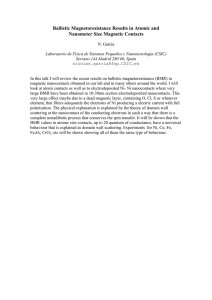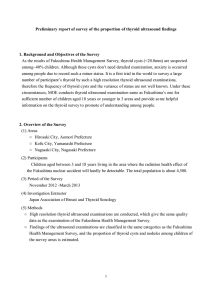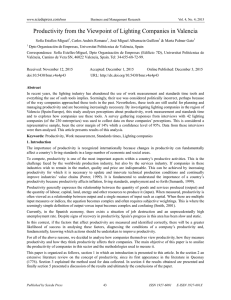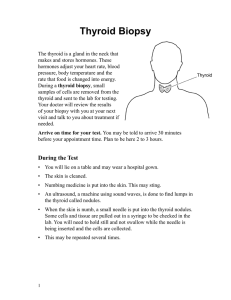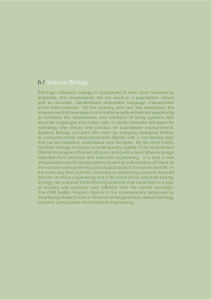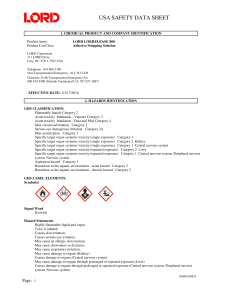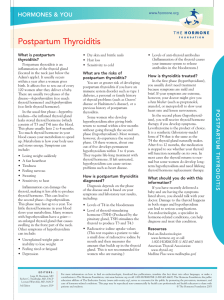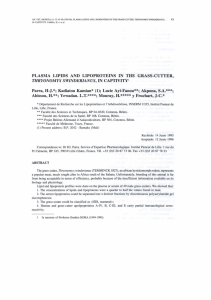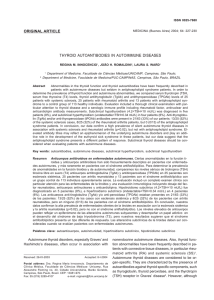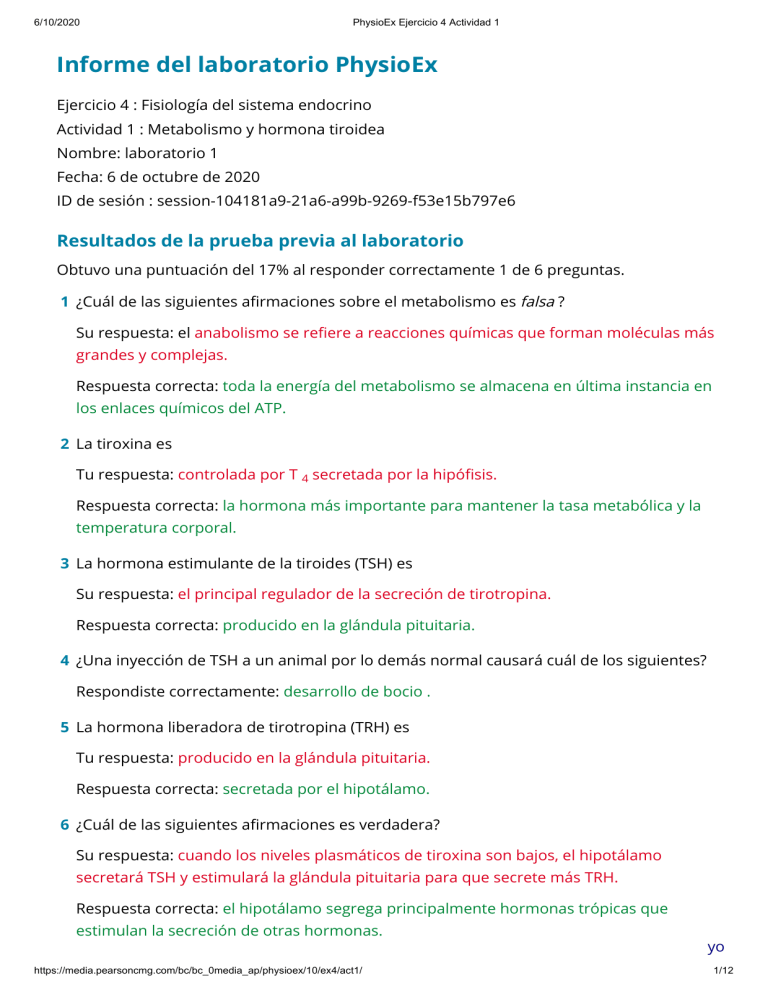
6/10/2020 PhysioEx Ejercicio 4 Actividad 1 Informe del laboratorio PhysioEx Ejercicio 4 : Fisiología del sistema endocrino Actividad 1 : Metabolismo y hormona tiroidea Nombre: laboratorio 1 Fecha: 6 de octubre de 2020 ID de sesión : session-104181a9-21a6-a99b-9269-f53e15b797e6 Resultados de la prueba previa al laboratorio Obtuvo una puntuación del 17% al responder correctamente 1 de 6 preguntas. 1 ¿Cuál de las siguientes afirmaciones sobre el metabolismo es falsa ? Su respuesta: el anabolismo se refiere a reacciones químicas que forman moléculas más grandes y complejas. Respuesta correcta: toda la energía del metabolismo se almacena en última instancia en los enlaces químicos del ATP. 2 La tiroxina es Tu respuesta: controlada por T 4 secretada por la hipófisis. Respuesta correcta: la hormona más importante para mantener la tasa metabólica y la temperatura corporal. 3 La hormona estimulante de la tiroides (TSH) es Su respuesta: el principal regulador de la secreción de tirotropina. Respuesta correcta: producido en la glándula pituitaria. 4 ¿Una inyección de TSH a un animal por lo demás normal causará cuál de los siguientes? Respondiste correctamente: desarrollo de bocio . 5 La hormona liberadora de tirotropina (TRH) es Tu respuesta: producido en la glándula pituitaria. Respuesta correcta: secretada por el hipotálamo. 6 ¿Cuál de las siguientes afirmaciones es verdadera? Su respuesta: cuando los niveles plasmáticos de tiroxina son bajos, el hipotálamo secretará TSH y estimulará la glándula pituitaria para que secrete más TRH. Respuesta correcta: el hipotálamo segrega principalmente hormonas trópicas que estimulan la secreción de otras hormonas. https://media.pearsoncmg.com/bc/bc_0media_ap/physioex/10/ex4/act1/ yo 1/12 6/10/2020 PhysioEx Ejercicio 4 Actividad 1 Resultados del experimento Predecir preguntas 1 Pregunta de predicción 1: Haga una predicción sobre la tasa metabólica basal (TMB) de las ratas restantes en comparación con la TMB de la rata normal que acaba de medir. Su respuesta: no podrá medir la TMB de las ratas restantes. 2 Pregunta de predicción 2: ¿Qué crees que sucederá después de inyectar tiroxina en las tres ratas? Su respuesta: la rata hipofisectomizada se volverá hipertiroidea y desarrollará un bocio. 3 Predict Question 3: What do you think will happen after you inject TSH into the three rats? Your answer: The normal rat will become hyperthyroidic and will not develop a goiter. 4 Predict Question 4: Propylthiouracil (PTU) is a drug that inhibits the production of thyroxine by blocking the attachment of iodine to tyrosine residues in the follicle cells of the thyroid gland (iodinated tyrosines are linked together to form thyroxine). What do you think will happen after you inject PTU into the three rats? Your answer: The normal rat will become hypothyroidic and develop a goiter. Stop & Think Questions 1 Calculate the oxygen consumption per hour for this rat using the following equation. ml O2 consumed/1 minute x 60 minutes/hour = ml O2/hour Enter the oxygen consumption per hour. You answered: 60 ml O2/hr. 2 Now that you have calculated the oxygen consumption per hour for this rat, you can calculate the metabolic rate per kilogram of body weight with the following equation (note that you need to convert the weight data from grams to kilograms to use this equation). Metabolic rate = (ml O2/hr)/(weight in kg) = ml O2/kg/hr Enter the metabolic rate. You answered: 60 ml O2/kg/hr. 3 Calculate the oxygen consumption per hour for this rat using the following equation. ml O2 consumed/1 minute x 60 minutes/hour = ml O2/hour https://media.pearsoncmg.com/bc/bc_0media_ap/physioex/10/ex4/act1/ yo 2/12 6/10/2020 PhysioEx Ejercicio 4 Actividad 1 Enter the oxygen consumption per hour. You did not answer this question. 4 Now that you have calculated the oxygen consumption per hour for this rat, you can calculate the metabolic rate per kilogram of body weight with the following equation (note that you need to convert the weight data from grams to kilograms to use this equation). Metabolic rate = (ml O2/hr)/(weight in kg) = ml O2/kg/hr Enter the metabolic rate. You did not answer this question. 5 Calculate the oxygen consumption per hour for this rat using the following equation. ml O2 consumed/1 minute x 60 minutes/hour = ml O2/hour Enter the oxygen consumption per hour. You did not answer this question. 6 Now that you have calculated the oxygen consumption per hour for this rat, you can calculate the metabolic rate per kilogram of body weight with the following equation (note that you need to convert the weight data from grams to kilograms to use this equation). Metabolic rate = (ml O2/hr)/(weight in kg) = ml O2/kg/hr Enter the metabolic rate. You did not answer this question. 7 Judging from their basal metabolic rates (an indicator of thyroid function), categorize the rats as hypothyroid (low thyroid levels; BMR below 1600), euthyroid ("good," or normal, thyroid levels; BMR = 1650-1750), or hyperthyroid (high thyroid levels; BMR above 1800). The normal rat is Your answer: hypothyroid. Correct answer: euthyroid. 8 Judging from their basal metabolic rates (an indicator of thyroid function), categorize the rats as hypothyroid (low thyroid levels; BMR below 1600), euthyroid ("good," or normal, yo https://media.pearsoncmg.com/bc/bc_0media_ap/physioex/10/ex4/act1/ 3/12 6/10/2020 PhysioEx Ejercicio 4 Actividad 1 thyroid levels; BMR = 1650-1750), or hyperthyroid (high thyroid levels; BMR above 1800). The thyroidectomized (Tx) rat is Your answer: euthyroid. Correct answer: hypothyroid. 9 Judging from their basal metabolic rates (an indicator of thyroid function), categorize the rats as hypothyroid (low thyroid levels; BMR below 1600), euthyroid ("good," or normal, thyroid levels; BMR = 1650-1750), or hyperthyroid (high thyroid levels; BMR above 1800). The hypophysectomized (Hypox) rat is Your answer: euthyroid. Correct answer: hypothyroid. 10 Calculate the oxygen consumption per hour for this rat using the following equation. ml O2 consumed/1 minute x 60 minutes/hour = ml O2/hour Enter the oxygen consumption per hour. You did not answer this question. 11 Now that you have calculated the oxygen consumption per hour for this rat, you can calculate the metabolic rate per kilogram of body weight with the following equation (note that you need to convert the weight data from grams to kilograms to use this equation). Metabolic rate = (ml O2/hr)/(weight in kg) = ml O2/kg/hr Enter the metabolic rate. You did not answer this question. 12 Calculate the oxygen consumption per hour for this rat using the following equation. ml O2 consumed/1 minute x 60 minutes/hour = ml O2/hour Enter the oxygen consumption per hour. You did not answer this question. 13 Now that you have calculated the oxygen consumption per hour for this rat, you can calculate the metabolic rate per kilogram of body weight with the following equation (note that you need to convert the weight data from grams to kilograms to use this https://media.pearsoncmg.com/bc/bc_0media_ap/physioex/10/ex4/act1/ yo 4/12 6/10/2020 PhysioEx Ejercicio 4 Actividad 1 equation). Metabolic rate = (ml O2/hr)/(weight in kg) = ml O2/kg/hr Enter the metabolic rate. You did not answer this question. 14 Calculate the oxygen consumption per hour for this rat using the following equation. ml O2 consumed/1 minute x 60 minutes/hour = ml O2/hour Enter the oxygen consumption per hour. You did not answer this question. 15 Now that you have calculated the oxygen consumption per hour for this rat, you can calculate the metabolic rate per kilogram of body weight with the following equation (note that you need to convert the weight data from grams to kilograms to use this equation). Metabolic rate = (ml O2/hr)/(weight in kg) = ml O2/kg/hr Enter the metabolic rate. You did not answer this question. 16 Judging from their basal metabolic rates (an indicator of thyroid function), categorize the rats as hypothyroid (low thyroid levels; BMR below 1600), euthyroid ("good," or normal, thyroid levels; BMR = 1650-1750), or hyperthyroid (high thyroid levels; BMR above 1800) after the thyroxine injection. The normal rat is Your answer: hypothyroid. Correct answer: hyperthyroid. 17 Judging from their basal metabolic rates (an indicator of thyroid function), categorize the rats as hypothyroid (low thyroid levels; BMR below 1600), euthyroid ("good," or normal, thyroid levels; BMR = 1650-1750), or hyperthyroid (high thyroid levels; BMR above 1800) after the thyroxine injection. The thyroidectomized (Tx) rat is Your answer: euthyroid. yo https://media.pearsoncmg.com/bc/bc_0media_ap/physioex/10/ex4/act1/ 5/12 6/10/2020 PhysioEx Ejercicio 4 Actividad 1 Correct answer: hyperthyroid. 18 Judging from their basal metabolic rates (an indicator of thyroid function), categorize the rats as hypothyroid (low thyroid levels; BMR below 1600), euthyroid ("good," or normal, thyroid levels; BMR = 1650-1750), or hyperthyroid (high thyroid levels; BMR above 1800) after the thyroxine injection. The hypophysectomized (Hypox) rat is Your answer: euthyroid. Correct answer: hyperthyroid. 19 Which of the rats developed a goiter after injection with thyroxine? Your answer: the hypophysectomized rat. Correct answer: None of the rats developed a goiter with this injection. 20 Calculate the oxygen consumption per hour for this rat using the following equation. ml O2 consumed/1 minute x 60 minutes/hour = ml O2/hour Enter the oxygen consumption per hour. You did not answer this question. 21 Now that you have calculated the oxygen consumption per hour for this rat, you can calculate the metabolic rate per kilogram of body weight with the following equation (note that you need to convert the weight data from grams to kilograms to use this equation). Metabolic rate = (ml O2/hr)/(weight in kg) = ml O2/kg/hr Enter the metabolic rate. You did not answer this question. 22 Calculate the oxygen consumption per hour for this rat using the following equation. ml O2 consumed/1 minute x 60 minutes/hour = ml O2/hour Enter the oxygen consumption per hour. You did not answer this question. 23 Now that you have calculated the oxygen consumption per hour for this rat, you can calculate the metabolic rate per kilogram of body weight with the following equation https://media.pearsoncmg.com/bc/bc_0media_ap/physioex/10/ex4/act1/ yo 6/12 6/10/2020 PhysioEx Ejercicio 4 Actividad 1 (note that you need to convert the weight data from grams to kilograms to use this equation). Metabolic rate = (ml O2/hr)/(weight in kg) = ml O2/kg/hr Enter the metabolic rate. You did not answer this question. 24 Calculate the oxygen consumption per hour for this rat using the following equation. ml O2 consumed/1 minute x 60 minutes/hour = ml O2/hour Enter the oxygen consumption per hour. You did not answer this question. 25 Now that you have calculated the oxygen consumption per hour for this rat, you can calculate the metabolic rate per kilogram of body weight with the following equation (note that you need to convert the weight data from grams to kilograms to use this equation). Metabolic rate = (ml O2/hr)/(weight in kg) = ml O2/kg/hr Enter the metabolic rate. You did not answer this question. 26 Judging from their basal metabolic rates (an indicator of thyroid function), categorize the rats as hypothyroid (low thyroid levels; BMR below 1600), euthyroid ("good," or normal, thyroid levels; BMR = 1650-1750), or hyperthyroid (high thyroid levels; BMR above 1800) after the TSH injection. The normal rat is Your answer: euthyroid. Correct answer: hyperthyroid. 27 Judging from their basal metabolic rates (an indicator of thyroid function), categorize the rats as hypothyroid (low thyroid levels; BMR below 1600), euthyroid ("good," or normal, thyroid levels; BMR = 1650-1750), or hyperthyroid (high thyroid levels; BMR above 1800) after the TSH injection. The thyroidectomized (Tx) rat is Your answer: euthyroid. https://media.pearsoncmg.com/bc/bc_0media_ap/physioex/10/ex4/act1/ yo 7/12 6/10/2020 PhysioEx Ejercicio 4 Actividad 1 Correct answer: hypothyroid. 28 Judging from their basal metabolic rates (an indicator of thyroid function), categorize the rats as hypothyroid (low thyroid levels; BMR below 1600), euthyroid ("good," or normal, thyroid levels; BMR = 1650-1750), or hyperthyroid (high thyroid levels; BMR above 1800) after the TSH injection. The hypophysectomized (Hypox) rat is You correctly answered: hyperthyroid. 29 Which of the rats did not develop a goiter after injection with TSH? Your answer: the hypophysectomized rat. Correct answer: the thyroidectomized rat. 30 Calculate the oxygen consumption per hour for this rat using the following equation. ml O2 consumed/1 minute x 60 minutes/hour = ml O2/hour Enter the oxygen consumption per hour. You did not answer this question. 31 Now that you have calculated the oxygen consumption per hour for this rat, you can calculate the metabolic rate per kilogram of body weight with the following equation (note that you need to convert the weight data from grams to kilograms to use this equation). Metabolic rate = (ml O2/hr)/(weight in kg) = ml O2/kg/hr Enter the metabolic rate. You did not answer this question. 32 Calculate the oxygen consumption per hour for this rat using the following equation. ml O2 consumed/1 minute x 60 minutes/hour = ml O2/hour Enter the oxygen consumption per hour. You did not answer this question. 33 Now that you have calculated the oxygen consumption per hour for this rat, you can calculate the metabolic rate per kilogram of body weight with the following equation (note that you need to convert the weight data from grams to kilograms to use this https://media.pearsoncmg.com/bc/bc_0media_ap/physioex/10/ex4/act1/ yo 8/12 6/10/2020 PhysioEx Ejercicio 4 Actividad 1 equation). Metabolic rate = (ml O2/hr)/(weight in kg) = ml O2/kg/hr Enter the metabolic rate. You did not answer this question. 34 Calculate the oxygen consumption per hour for this rat using the following equation. ml O2 consumed/1 minute x 60 minutes/hour = ml O2/hour Enter the oxygen consumption per hour. You did not answer this question. 35 Now that you have calculated the oxygen consumption per hour for this rat, you can calculate the metabolic rate per kilogram of body weight with the following equation (note that you need to convert the weight data from grams to kilograms to use this equation). Metabolic rate = (ml O2/hr)/(weight in kg) = ml O2/kg/hr Enter the metabolic rate. You did not answer this question. 36 Judging from their basal metabolic rates (an indicator of thyroid function), categorize the rats as hypothyroid (low thyroid levels; BMR below 1600), euthyroid ("good," or normal, thyroid levels; BMR = 1650-1750), or hyperthyroid (high thyroid levels; BMR above 1800) after the PTU injection. The normal rat is Your answer: hyperthyroid. Correct answer: hypothyroid. 37 Judging from their basal metabolic rates (an indicator of thyroid function), categorize the rats as hypothyroid (low thyroid levels; BMR below 1600), euthyroid ("good," or normal, thyroid levels; BMR = 1650-1750), or hyperthyroid (high thyroid levels; BMR above 1800) after the PTU injection. The thyroidectomized (Tx) rat is You correctly answered: hypothyroid. yo https://media.pearsoncmg.com/bc/bc_0media_ap/physioex/10/ex4/act1/ 9/12 6/10/2020 PhysioEx Ejercicio 4 Actividad 1 38 Judging from their basal metabolic rates (an indicator of thyroid function), categorize the rats as hypothyroid (low thyroid levels; BMR below 1600), euthyroid ("good," or normal, thyroid levels; BMR = 1650-1750), or hyperthyroid (high thyroid levels; BMR above 1800) after the PTU injection. The hypophysectomized (Hypox) rat is You correctly answered: hypothyroid. 39 Which of the rats developed a goiter after injection with PTU? Your answer: the hypophysectomized rat. Correct answer: the normal rat. Experiment Data Post-lab Quiz Results You scored 14% by answering 1 out of 7 questions correctly. 1 How would you treat a thyroidectomized animal so that it functions like a "normal" animal? Your answer: Provide the animal TRH supplements. Correct answer: Provide the animal T4 supplements. 2 As a result of the missing hormone(s) in the hypophysectomized rat, what would be an expected symptom? Your answer: hyperactivity. Correct answer: decreased basal metabolic rate. 3 An injection of thyroxine to an otherwise normal rat will cause which of the following? Your answer: high levels of TSH secretion. Correct answer: hyperthyroidism. 4 Why didn't any of the rats develop a goiter after thyroxine injection? Your answer: In all cases, negative feedback mechanisms were impaired. Correct answer: In all cases, TSH levels were not elevated by the thyroxine injection. 5 Why did the normal rat develop a palpable goiter with the TSH injection? Your answer: The TSH receptors in the hypothalamus were overstimulated. Correct answer: The TSH receptors on the thyroid gland were excessively stimulated. yo https://media.pearsoncmg.com/bc/bc_0media_ap/physioex/10/ex4/act1/ 10/12 6/10/2020 PhysioEx Ejercicio 4 Actividad 1 6 An injection of propylthiouracil to an otherwise normal animal will cause which of the following? You correctly answered: goiter development. 7 Why did the normal rat develop a palpable goiter with the propylthiouracil injection? Your answer: The secretion of TRH was impaired by the drug. Correct answer: The injection decreased the negative feedback mechanism on TSH. Review Sheet Results 1 Part 1: Determining the Basal Metabolic Rates Which rat had the fastest basal metabolic rate (BMR)? You did not answer this question. 2 Why did the metabolic rates differ between the normal rat and the surgically altered rats? How well did the results compare with your prediction? You did not answer this question. 3 If an animal has been thyroidectomized, what hormone(s) would be missing in its blood? You did not answer this question. 4 If an animal has been hypophysectomized, what effect would you expect to observe in the hormone levels in its body? You did not answer this question. 5 Part 2: Determining the Effect of Thyroxine on Metabolic Rate What was the effect of thyroxine injections on the normal rat's BMR? You did not answer this question. 6 What was the effect of thyroxine injections on the thyroidectomized rat's BMR? How does the BMR in this case compare with the normal rat's BMR? Was the dose of thyroxine in the syringe too large, too small, or just right? You did not answer this question. 7 What was the effect of thyroxine injections on the hypophysectomized rat's BMR? How does the BMR in this case compare with the normal rat's BMR? Was the dose of thyroxine in the syringe too large, too small, or just right? You did not answer this question. yo https://media.pearsoncmg.com/bc/bc_0media_ap/physioex/10/ex4/act1/ 11/12 6/10/2020 PhysioEx Ejercicio 4 Actividad 1 8 Part 3: Determining the Effect of TSH on Metabolic Rate What was the effect of thyroid-stimulating hormone (TSH) injections on the normal rat's BMR? You did not answer this question. 9 What was the effect of TSH injections on the thyroidectomized rat's BMR? How does the BMR in this case compare with the normal rat's BMR? Why was this effect observed? You did not answer this question. 10 What was the effect of TSH injections on the hypophysectomized rat's BMR? How does the BMR in this case compare with the normal rat's BMR? Was the dose of TSH in the syringe too large, too small, or just right? You did not answer this question. 11 Part 4: Determining the Effect of Propylthiouracil on Metabolic Rate What was the effect of propylthiouracil (PTU) injections on the normal rat's BMR? Why did this rat develop a palpable goiter? You did not answer this question. 12 What was the effect of PTU injections on the thyroidectomized rat's BMR? How does the BMR in this case compare with the normal rat's BMR? Why was this effect observed? You did not answer this question. 13 What was the effect of PTU injections on the hypophysectomized rat's BMR? How does the BMR in this case compare with the normal rat's BMR? Why was this effect observed? You did not answer this question. yo https://media.pearsoncmg.com/bc/bc_0media_ap/physioex/10/ex4/act1/ 12/12

